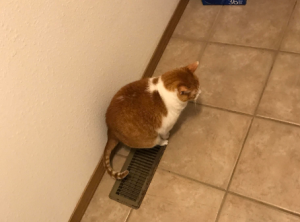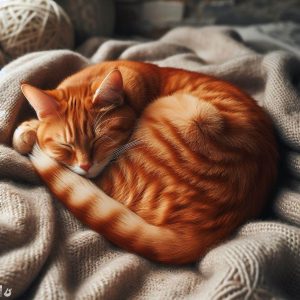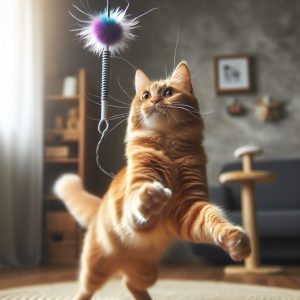The pungent aroma hits your nose as soon as you open the front door. That’s right – your precious feline has once again urinated inside the air vent. As you scrub and disinfect the grated metal slats for the umpteenth time, frustration mounts. Cat keeps peeing in the air vent – why does my cat keep using the air vent as their personal litter box?
This perplexing and vexing behavior leaves many cat parents scratching their heads. Is your cat somehow clueless about where waste should go? Are they acting out of vengeance for some offense? Do they enjoy creating a mess?
The answer is none of the above. Cats aren’t doing this out of confusion, spite, or defiance. There’s always an underlying motivation driving a cat’s elimination habits. Pinpointing the cause is key to resolving vent peeing for good. With some cat psychology knowledge and targeted troubleshooting, you can crack the case of the vent-peeing cat.
In this exhaustive guide, we’ll go deep on all possible reasons for the air vent bathroom habit, provide actionable solutions to retrain your cat, and give tips to prevent repeat occurrences in the future. If you’re dealing with a vent-peeing feline, read on to start getting to the bottom of what’s really prompting this inappropriate toilet choice.
Reason #1 for Vent Peeing: Medical Issues
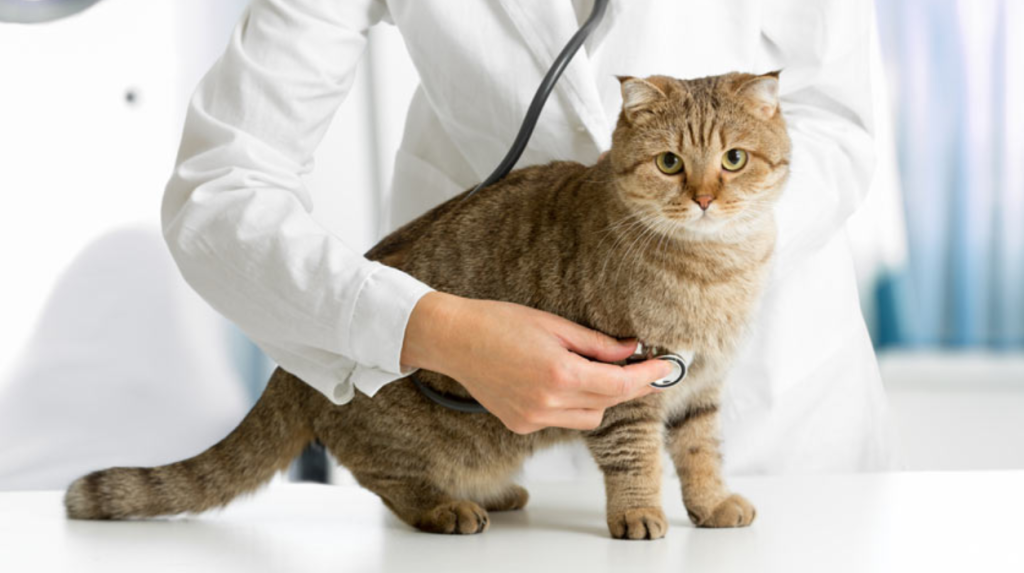
One of the first things any cat parent should do when litter box problems arise is schedule a vet visit to rule out medical conditions. Cats are masters at masking illness until it’s quite advanced. Any sudden changes in elimination habits could signal health issues that require prompt treatment.
Urinary Tract Infections
A urinary tract infection (UTI) is a common cause of abnormal urination. Bacteria in urine creates intense pain and irritation in the bladder and urethra. Your cat associates this discomfort with their litter box and starts seeking alternatives.
UTIs also cause an urgent and frequent need to pee. When they have to go, the cold metal vent provides immediate relief. Unless the infection is treated, the vent peeing will continue.
Kidney Disease
Kidney disease is prevalent in older cats. Kidneys filter waste from the bloodstream – when damaged, they can’t do this effectively. Toxins then accumulate and get excreted through urine.
Cats with failing kidneys develop increased thirst and urine output. They simply can’t hold their bladder as long. The vent provides a quick and easy place to relieve themselves.
Diabetes
The hallmark symptom of diabetes in cats is excessive thirst and urination. Their bodies can’t regulate blood sugar, requiring more fluid intake. All that extra drinking leads to far more pee.
Rather than trek to the regular litter box, a diabetic cat might opt to hastily pee in the convenient air vent when their bladder is full. Getting a urine sample checked for glucose is an easy way to test for diabetes.
Arthritis
The discomfort of arthritis can make climbing in and out of litter boxes challenging. Air vents close to the floor are far more accessible. The cold metal might also provide some soothing relief for achy joints.
Other Conditions
Any condition causing frequent urination, mobility issues, or litter box discomfort could lead a cat to seek alternative pee sites.
Hyperthyroidism, constipation, cancer, bladder stones, cystitis, and other common cat illnesses can prompt vent peeing. Only diagnostic tests and a thorough exam can determine if disease is the cause.
Key Takeaway
Sudden inappropriate peeing definitely warrants a full check-up. Treating any medical issue revealed should stop vent urination assuming that was the sole cause. It’s the first and most crucial step in resolving this undesirable behavior.
Reason #2: Anxiety, Stress, and Fear
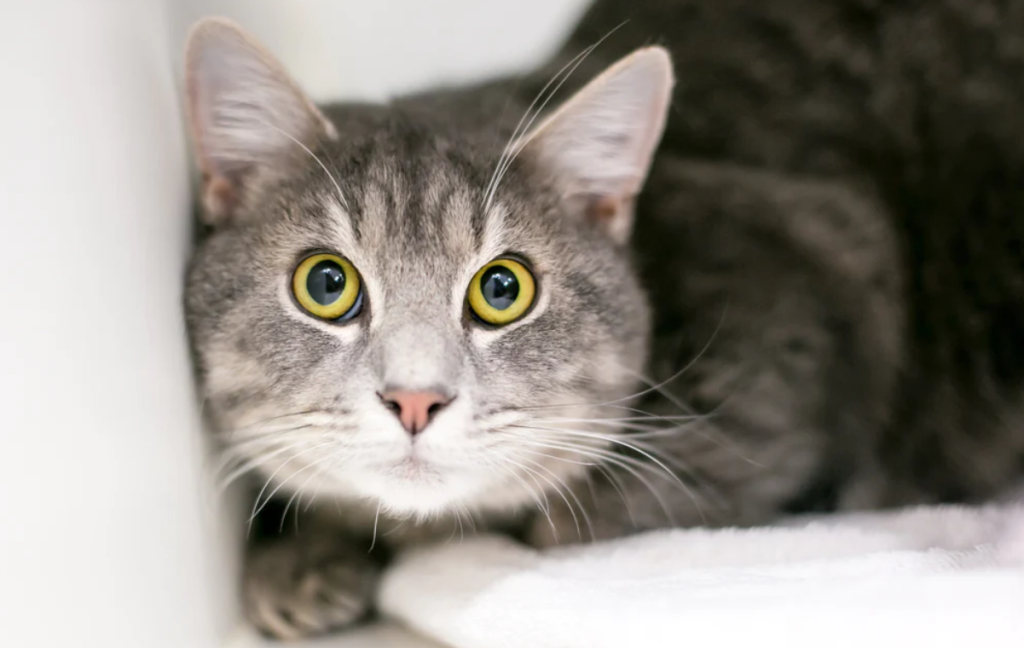
Cats are extremely sensitive creatures of habit. Any disruption in their environment, routine, or relationships can create significant stress and anxiety. Nervous cats begin urine marking to comfort themselves and reclaim stability.
Here are common scenarios that trigger apprehension and thereby vent urination:
New Baby in the Home
A new baby understandably shifts attention away from your cat. But they likely view the noisy, omnipresent infant as an invader disrupting their turf. The stress leads to marking behaviors.
New Person in Home
Beyond babies, any newcomer like a roommate, partner, or visiting relative can cause anxiety. Having their familiar home “invaded” makes cats feel insecure and provoked to mark.
New Cat in Home
Introducing a new feline, especially an adult, requires slow acclimation so territory disputes don’t erupt. Too much interaction too fast often results in vent marking by one or both cats.
New Dog or Pet
Even a non-feline addition like a puppy or guinea pig can overwhelm your cat. Their status is threatened, prompting marking. Slow, rewarded exposure is a must to prevent stress.
Remodeling and Redecorating
Cats acclimate to their environment. Major changes like painting, construction, or furniture moving make them uneasy since things no longer look, smell, or feel familiar. Marking brings calm.
Changing Food Bowls or Litter Box
While minor to us, shifting food bowl or litter box locations disorients cats who operate on auto-pilot. Unexpected change heightens stress, induces marking.
Disrupted Routine
Cats relish routine. Changes to their schedule, feeding times, play regimen, or sleep pattern can ignite anxiety. Sticking to a consistent rhythm makes them feel secure.
Nighttime Activity
Cats are crepuscular – most active at dawn and dusk. Lots of noise and disruption during their ordinary sleeping hours stresses them immensely. They mark to cope.
Relocation
Even short-term moves to a new home cause massive stress for cats. Their whole familiar environment is erased. Marking is inevitable as they try to acclimate. Proper precautions are essential for peaceful moves.
Conflict with Another Pet
Personality clashes with other animals in the home cause tension, provoking marking behaviors as they compete for security. Separate spaces reduce friction.
External Cat Conflict
Marking also results from seeing outdoor cats through windows or doors. Their turf feels threatened by sightings of neighbor cats or strays wandering the yard. Blocking sightlines helps prevent marking provoked by outdoor cats.
Abuse or Neglect
Current or past mistreatment, neglect, or trauma also manifests in eliminating outside the litter box long after adoption into a safe home. Patience, routine, and PTSD therapy assist recovery.
Key Takeaway
The most effective way to resolve anxiety-related vent peeing is identifying and modifying the source of stress. Maintaining consistency, providing hideouts, using calming aids, and preserving their preferred routines all help minimize environmental stressors.
Reason #3: Aversion to Litter Box
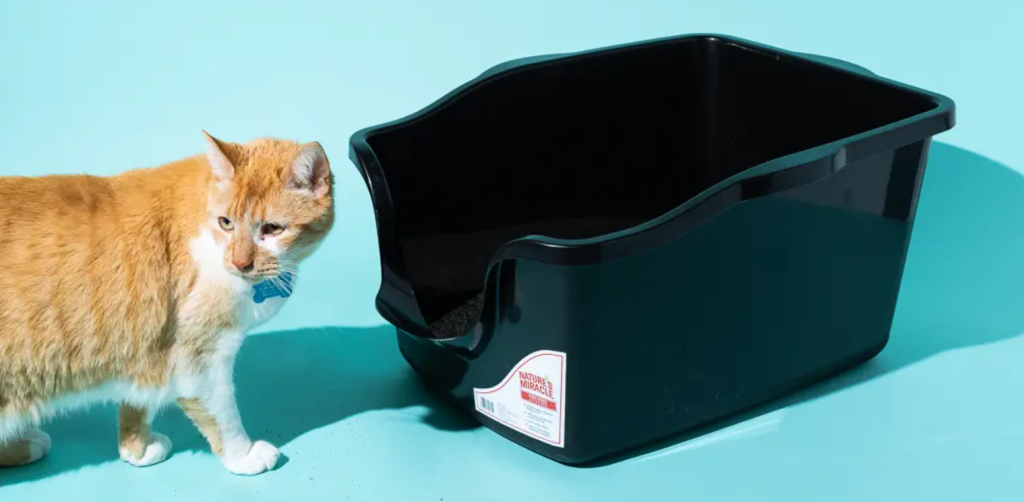
If your cat previously used their litter box without issue, a sudden aversion could be causing them to seek alternatives like air vents. Here’s how litter boxes often deter cats:
Dirty or Unkeeled Box
Nothing repels cats more than a messy box. They have fastidious hygiene standards. Scooping twice daily and changing litter completely every 1-2 weeks is vital.
Small, Covered Box
Cats need room to circle, sniff, paw, and scratch. Tiny boxes and covered designs cramp their process. Big, open tubs facilitate proper elimination.
Liners
Some cats dislike plastic liners inside litter boxes, avoiding contact. Liner textures or odors may irritate them. Removing liners often prevents avoidance.
Location Change
Cats grow accustomed to their box’s spot. Moving it disrupts their routine, especially to high traffic or loud areas. Keep litter boxes in consistent, peaceful locations.
Ambush Sites
If your cat was ever ambushed by another pet at the litter box, they likely avoid going again, associating danger. Creating safe, private spaces prevents this.
Painful Urination Episode
Any instances of constipation, bladder infection, cystitis, or other medical issues that caused painful peeing may have created lasting litter box avoidance due to those associations.
Switching Litters
Sudden litter type changes can deter cats who grow accustomed to certain textures and scents. Gradually transition between litters for easier acceptance.
Insufficient Cleaning
Especially with multiple cats, twice daily scooping may be insufficient if boxes become dirty before the next scheduled cleaning. Add additional midday scooping.
Sharing with Another Animal
Some cats refuse to share litter boxes with other pets. The smell of another animal is off-putting. Providing multiple dedicated boxes prevents this issue.
Key Takeaway
Essentially, cats want a spacious, consistently placed, immaculately clean litter box free of unpleasant textures, smells, or danger. Failing to meet those criteria will motivate them to go elsewhere.
Review the circumstances of your cat’s litter environment and habits to identify and resolve any shortcomings or negative associations that could be promoting vent usage over their box.
Reason #4: Marking Territory
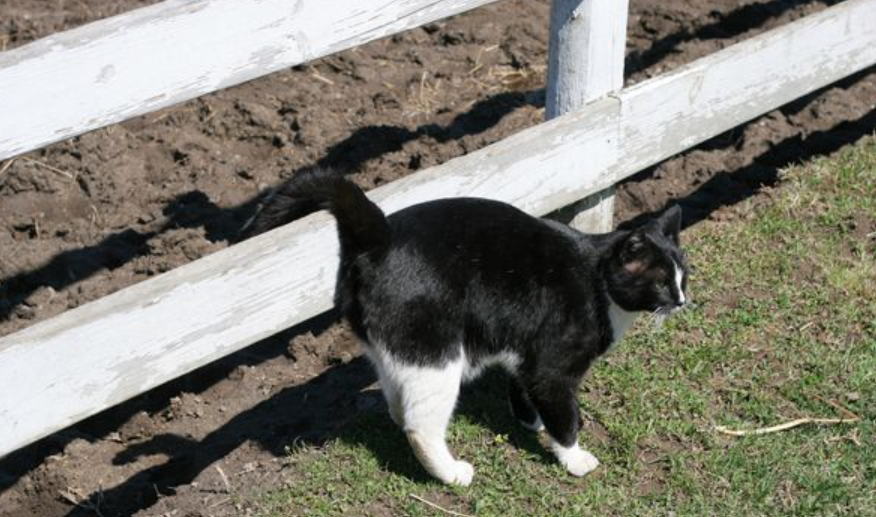
Whereas stressful marking is somewhat random, territorial marking tends to occur repeatedly on vertical objects like walls, furniture, or air vents. Why the vertical orientation?
Cats have scent glands in their paws, so scratching or urine spraying vertically leaves “visual and odor cues” about their turf at nose level for other cats. Some triggers for territorial marking include:
- A new cat within or around the home
- Frequently observing roaming neighborhood cats outdoors
- New people moving into or regularly visiting the home
- Introducing new pets
- Using new pungent cleaners or air fresheners
- Moving to a new home
In essence, anything that puts their status and turf claim in question can trigger urine marking. To curtail this cause of vent peeing, address the core issue making your cat feel insecure.
Introducing New Cats
When adding a new cat, go very slowly with scented item swapping, site swapping, and rewards. Rushing the intro fuels marking. Maintain separate key resources to reduce tension too.
New People
Acclimate cats to newcomers by keeping them in their safe room at first. Let them approach new people at their own pace, never forced. Manage stress levels to avoid marking.
Guests in Your Home
When hosting visitors, sequester your cat in a quiet room with litter, food, water, toys. Provide hiding spots and minimal interaction with company. Limit stay duration as well.
Outdoors Cats
Indoors cats will mark when spying neighborhood cats from windows. Close drapes and blinds or use decorative window film to block the view.
New Home
Moving launches extensive marking. Use synthetic pheromones and allow full, solo exploration of new home first. Follow their lead based on comfort level. Keep routine consistent.
Key Takeaway
The antidote to territorial marking is reducing the perceived threat. Maintain calm routines, limit disruptive visitors, block outdoor cats from view, use calming plug-ins. Meet marking urges proactively.
How to Stop A Cat From Urinating in the Vent
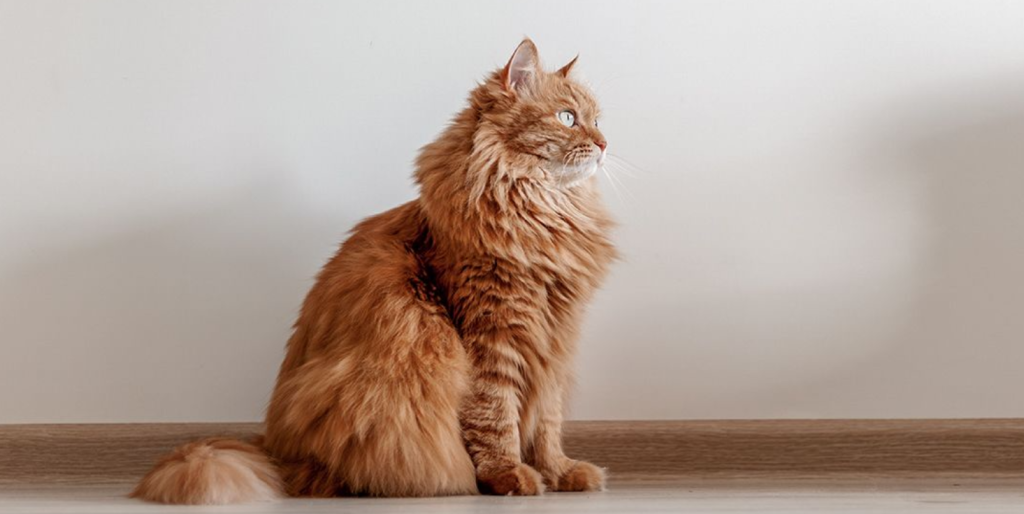
You’ve identified the likely causes for your cat’s air vent urination. Now it’s time to implement solutions to retrain them to use the litter box consistently. Here are effective approaches:
Completely Clean Soiled Areas
Before anything else, thoroughly eliminate all odor traces from peed-on vents. Use gloves and ventilation, then:
- Soak the area in an enzymatic cleaner made for pet stains. Let sit for 15 minutes to fully penetrate.
- Follow up with an odor neutralizer like OdoBan to complete eradication.
- Rinse with clean water and allow to fully dry. Lingering moisture keeps smell alive.
- Replace vent covers and ducts if any scent remains. Offensive odors encourage repeats!
Treat Any Medical Issues
If a urinary tract infection, kidney problem, arthritis, or other diagnosed medical condition caused the litter box avoidance, treating the illness should stop vent peeing once relief is achieved.
Follow vet instructions to properly administer medications, dietary changes, or anything else prescribed for treatment. Monitor your cat’s progress closely. Retraining takes patience but the medical issue must be fully resolved first.
Add More Litter Boxes
The general rule is one litter box per cat, plus an extra. So for a 2-cat home, have 3 boxes. This prevents bullying and lines.
Also place boxes in multiple spots your cat frequents around the home so there’s one never far away when needed. Offer different styles too like open trays, top-entry, and storage bench boxes to appeal to different preferences.
Having abundant, appealing litter box options nearby makes it less tempting for a cat to opt for the air vent instead!
Improve Remaining Litter Boxes
For any boxes they still may use, make each one as ideal and enticing as possible:
- Large, open trays (at least 1.5 times their length)
- Filled with 3-4 inches of an unscented, soft clumping litter
- Placed in a peaceful, low-traffic area
- Never near loud appliances or their food
- Scooped twice daily and sanitized weekly
- Washed monthly with soap and hot water to remove residue
The more flawless you keep each litter pan, the more motivated your cat will be to use it and stop considering alternative toilets.
Try Cat Attract Litter Additive
The natural herb and spice blend Cat Attract is proven to lure curious cats into checking out litter boxes. Simply sprinkle it over regular litter to help draw your cat back to appropriate potty spots. It works to re-establish good habits!
Use Pheromone Diffusers
Feliway makes plug-in diffusers that mimic a calming facial pheromone produced by cats. The ambient odor helps soothe cats and curb marking urges. Use one near previously soiled vents and the litter area.
Apply Deterrents
Make soiled spots unappealing:
- Arrange furniture to block vent access
- Use double-sided tape on surfaces
- Aluminum foil deters pawing at covers
- Motion-activated air sprayers startle them away
- Citrus or vinegar odors repel most cats
Deterrents teach them to avoid undesirable areas.
Try Anxiety Medications
For severe stress, medications can help in the short term while making long term environmental changes:
- Fluoxetine stops obsessive marking
- Benzodiazepines like Xanax reduce anxiety
- Cat appeasing pheromones deliver calming signals
Consult your vet about pharmacological options suitable for your cat. Used properly, they can be very effective when combined with other tactics.
Seek Professional Help
For chronic vent peeing not resolved by medical treatment, litter enhancements, cleaning, and other efforts, contact an expert animal behaviorist certified by the Animal Behavior Society who can assess your cat’s unique situation and offer specialized behavioral modification guidance. Their skills identify the root triggers and develop custom desensitization routines.
Preventing Recurrences
Once your cat is reliably using the litter box again, stay vigilant so the undesirable vent habit doesn’t return:
- Never skip a daily scooping or weekly litter change
- Refresh vent-area deterrents like foil monthly
- Continue using Feliway diffusers long term
- Limit unsupervised time for known vent urinaters
- Discuss medication discontinuation carefully with your vet
- Avoid environmental stressors and changes
- Stay observant for signs of recurrence
Consistency is key to ensuring the resolved behavior sticks long term! Don’t take shortcuts.
When to Seek Specialized Help
Despite meticulous medical care, litter enhancements, cleaning, deterrents, and medication, a small percentage of cats persist with vent peeing. At that point it’s smart to enlist a professional for tailored guidance:
- Board-certified veterinary behaviorists – Vets with dedicated training in cat psychology and behavior modification therapy.
- Certified applied animal behaviorists – Specialists with graduate degrees focused on clinically resolving animal conduct issues using scientifically sound principles of learning and behavior.
- Certified cat behavior consultants – Experts certified by the International Association of Animal Behavior Consultants experienced in ending unwanted cat actions using positive reinforcement, environmental changes, and stress reduction methods.
Their wealth of knowledge on stubborn cases provides the best chance of pinpointing causes, designing customized desensitization programs, and stopping vent urination problems once and for all.
Key Takeaways on Vent Peeing Cats
- Medical problems often cause initial litter box avoidance
- Stress, territorial marking, and litter box aversion are common motivators too
- Identifying the underlying reason allows appropriate corrections
- Thoroughly cleaning soiled vents is imperative
- Litter box hygiene and enhancement coaxes cats back
- Pheromones, meds, deterrents, and behavior modification curb stressors fueling the behavior
- Patience, detective work, and trying various approaches leads to success!
While having your cat repeatedly urinate inside air vents, heating ducts, and wall registers is incredibly aggravating and unpleasant, there are solutions. By playing pet detective to unravel the motivations behind vent peeing and taking action to resolve those root causes, you can successfully redirect your cat back to using the litter box consistently. That means no more unpleasant aroma of cat pee permeating your home! Never give up on stopping the unwanted potty habit. A fresh-smelling, pee-free home awaits.

